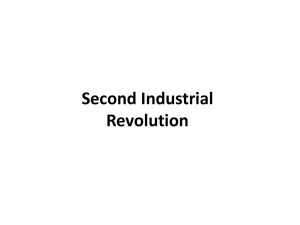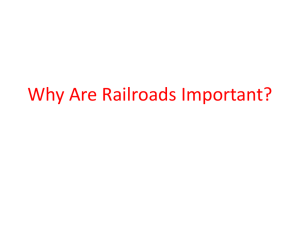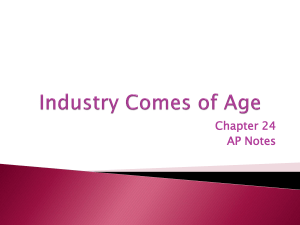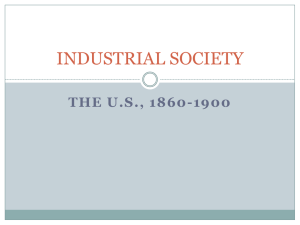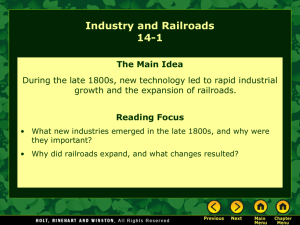Industry Comes of Age Chapter 24 AP Notes
advertisement
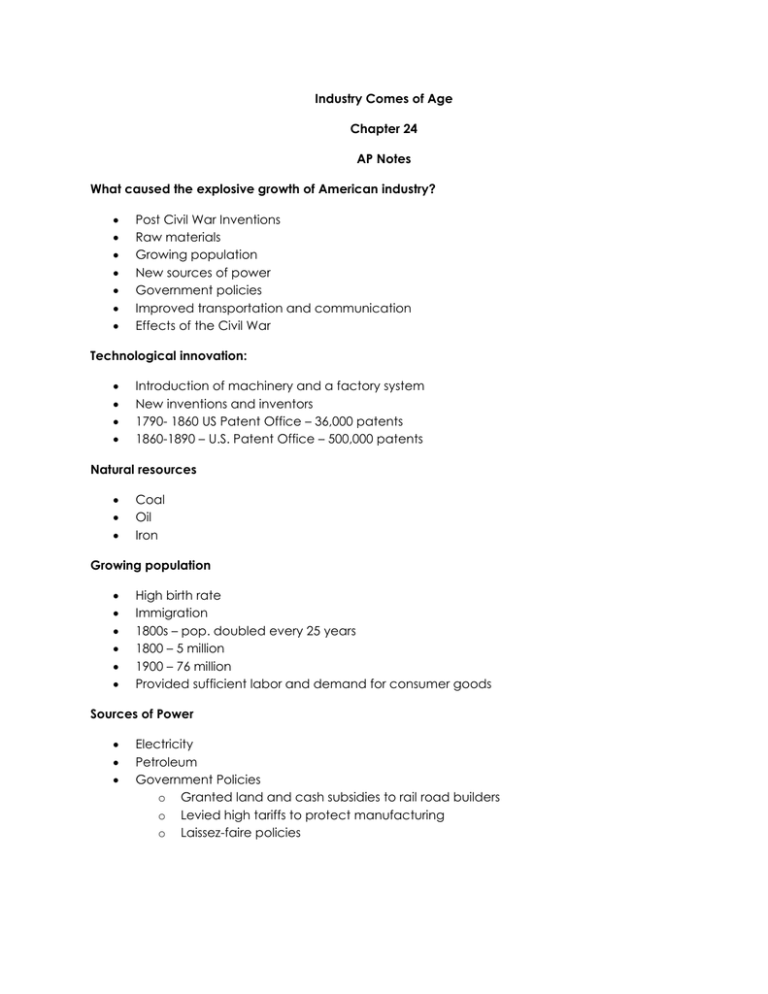
Industry Comes of Age Chapter 24 AP Notes What caused the explosive growth of American industry? Post Civil War Inventions Raw materials Growing population New sources of power Government policies Improved transportation and communication Effects of the Civil War Technological innovation: Introduction of machinery and a factory system New inventions and inventors 1790- 1860 US Patent Office – 36,000 patents 1860-1890 – U.S. Patent Office – 500,000 patents Natural resources Coal Oil Iron Growing population High birth rate Immigration 1800s – pop. doubled every 25 years 1800 – 5 million 1900 – 76 million Provided sufficient labor and demand for consumer goods Sources of Power Electricity Petroleum Government Policies o Granted land and cash subsidies to rail road builders o Levied high tariffs to protect manufacturing o Laissez-faire policies Improved Transportation and Communication Railroads Telegraph Telephone Effects of the War: Industry prospered Emergence of a millionaire class Liquid capital –people had money to invest and spend Increased mechanization Government now in the hands of the Republican Party with pro-business policies Significance of Railroads: Key to industrial growth Created a national market Allowed people to settle the Great Plains Maker of millionaires Demand for steel – spurred iron and steel industries Creation of 4 time zones After the Civil War: Railroad production grew Deadlock over route for transcontinental railroad broken Union Pacific Railroad – west from Omaha Central Pacific RR from California 1869 – met at Odgen, Utah Binding the Country with Railroad Ties Northern Pacific RR – L. Superior -Puget Sound Atchison, Topeka, and Santa Fe – through southwest Southern Pacific – New Orleans - San Francisco Great Northern – Duluth - Seattle Innovations in railroading: Westinghouse air brake Steel rails Uniform signaling system along track lines Standard gauge = 4’8” Pullman Palace Cars Time zones Government assistance: Subsidies Loans Land grants 155,504,994 acres along routes – alternate one-mile sq. sections choicest sections closest to the rail lines Why was the government so generous? Railroads expensive to build West was thinly populated – risky investment Military and postal needs Encourage population to move into Great Plains Tie nation together economically How did railroads affect Am. life? Nation united physically Raw materials from the West transported East Manufactured goods from the East transported West Stimulated mining and agriculture in the West Stimulated growth of cities Stimulated immigration Railroad abuses? Corruption – Credit Mobilier Scandal “Stock watering” Bribed judges and legislatures – free passes Natural monopoly Pools Rebates Charge higher rates for short haul than long Public reaction? Being “railroaded” Farmers particularly at the mercy of railroads Midwestern legislatures tried to regulate railroads – unconstitutional (Wabash case) – states can not regulate interstate commerce Interstate Commerce Act of 1887 Prohibited rebates Required the railroads to publish rates openly Outlawed charging more for short haul Forbade discrimination against shippers Established the Interstate Commerce Commission to enforce law 1st attempt by Washington to regulate big business in the public interest Elimination of Competition Competition was wasteful Vertical integration – Carnegie Steel Horizontal integration – trusts – Rockefeller and Standard Oil Company Interlocking directorates – J.P. Morgan and banking “Steel is King!” Heavy industry – capital goods Bessemer process made cheap steel possible By 1900 U.S. producing as much as Great Britain and Germany combined Andrew Carnegie Carnegie Steel “Watch the costs – profits will take care of themselves” Vertical consolidation 1900 - $40 million profit Philanthropist The Gospel of Wealth Carnegie’s philosophy The wealthy are entrusted with the public wealth and must use is wisely Gave away the bulk of his fortune - $350 million Libraries Church organs Schools J.P. Morgan “Banker’s Banker” Wall Street banker – financed railroads, insurance cos., and banks Bought Carnegie Steel for $0.5 billion Created U.S. Steel – 1st $1 billion company John D. Rockefeller 1870 – organized Standard Oil Company 1877 controlled 95% of nation’s oil Forced competitors out of business – Social Darwinism Survival of the fittest The wealthy are rich because they worked hard and are the product of natural selection The poor need to work harder – pull themselves up by the “bootstraps” Captains of Industry Employed thousands of workers Increased availability of goods Raised the standard of living Built factories, raised productivity, expanded markets Philanthropists Or Robber Barons? Built fortunes stealing from the public Drained the country of natural resources Corrupted public officials to interpret laws in their favor Drove competition out of business Paid meager wages and forced workers to work under dangerous and unhealthy conditions Public Reaction ? Concern – monopolies could hurt the consumer and worker Sherman Anti – Trust Act of 1890 Outlawed trusts and other combinations in restraint of trade Vague and not well enforce Supreme Court usually favored big business The South and Industry? 1900 produced smaller % of nation’s manufactured goods than before C.W. RR gave favorable rates to northern industry in competition with southern Textile mills Close to the source of raw materials Cheap labor Impact? Economy dominated by a few large companies – Standard Oil, U.S. Steel, General Electric, Swift and Armour, AT&T, Westinghouse, and DuPont 1900 1/10 of the population owned 9/10 of the wealth Changes in Labor? unskilled/impersonal factory work schedule Hardships of Labor? 12 hrs/day 6 days/week Child labor Unsafe conditions – accidents were a normal risk in working Management fought safety and health standards Obstacles to Labor Unity? Immigration – cheap labor Ethnic and racial divisions Religious divisions Skilled vs. unskilled Divided by crafts Middle class fears of radicalism Knights of Labor Organized all wage earners Goals: o Equal pay for equal work o Graduated income tax o End to child labor o Cooperative ownership of factories o Strategies – restrict immigration and strikes Strikes and Labor Violence Great Railroad Strike of 1877 Haymarket Square -1886 Homestead Strike – 1892 Pullman Strike – 1894 Middle class Americans saw violence, radicalism, unions and immigration as all related. Knights of Labor Success: o Won strike against Jay Gould’s Wabash RR o 600,000 joined Failure: o Too big and diverse o Political goals o Later strikes unsuccessful Leadership: Terence Powderly American Federation of Labor Loose federation of skilled trades Goals: o Bread and butter issues – wages, hours, safety o Union recognition and closed shop o Collective bargaining Leadership: Samuel Gompers Success: Steady – conservative – still exists today
